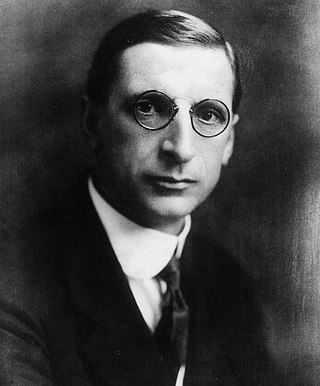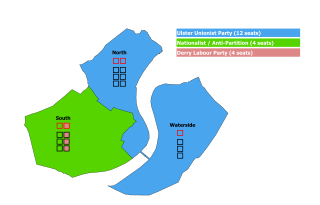
The Parliament of Northern Ireland was the home rule legislature of Northern Ireland, created under the Government of Ireland Act 1920, which sat from 7 June 1921 to 30 March 1972, when it was suspended because of its inability to restore order during the Troubles, resulting in the introduction of direct rule. It was abolished under the Northern Ireland Constitution Act 1973.

The Irish component of the 1918 United Kingdom general election took place on 14 December 1918. It was the final United Kingdom general election to be held throughout Ireland, as the next election would happen following Irish independence. It is a key moment in modern Irish history, seeing the overwhelming defeat of the moderate nationalist Irish Parliamentary Party (IPP), which had dominated the Irish political landscape since the 1880s, and a landslide victory for the radical Sinn Féin party. Sinn Féin had never previously stood in a general election, but had won six seats in by-elections in 1917–1918. The party had vowed in its manifesto to establish an independent Irish Republic. In Ulster, however, the Unionist Party was the most successful party.

The 1921 Irish elections took place in Ireland on 24 May 1921 to elect members of the House of Commons of Northern Ireland and the House of Commons of Southern Ireland. These legislatures had been established by the Government of Ireland Act 1920, which granted Home Rule to a partitioned Ireland within the United Kingdom.

The 1925 Northern Ireland general election was held on 3 April 1925. It was the second election to the Parliament of Northern Ireland. It saw significant losses for the Ulster Unionist Party, although they maintained their large majority. This was the last election for the Stormont parliament conducted using Single transferable voting, a form of Proportional Representation. Fifty-two members were elected in ten districts, which each elected between four and eight members. The Ulster Unionist government abolished proportional representation during this parliament and replaced it with the first-past-the-post system used in Great Britain.

The 1945 Northern Ireland general election was held on 14 June 1945. The election saw significant losses for the Ulster Unionist Party, though they retained their majority.

The 1965 Northern Ireland general election was held on 25 November 1965. Like all previous elections to the Parliament of Northern Ireland, it produced a large majority for the Ulster Unionist Party.

The 1962 Northern Ireland general election was held on 31 May 1962. While the Ulster Unionist Party lost three seats, they retained a large majority as in all previous elections to the Parliament of Northern Ireland.

The 1958 Northern Ireland general election was called on 27 February by 1st Viscount Brookeborough to be held on 20 March 1958.

The 1953 Northern Ireland general election was held on 22 October 1953. Like all previous elections to the Parliament of Northern Ireland, it produced a large majority for the Ulster Unionist Party.

The 1938 Northern Ireland general election was held on 9 February 1938. Like all previous elections to the Parliament of Northern Ireland, it produced a large majority for the Ulster Unionist Party, who won three-quarters of the seats.

The 1933 Northern Ireland general election was held on 30 November 1933. Like all previous elections to the Parliament of Northern Ireland, it produced a large majority for the Ulster Unionist Party.

The 1929 Northern Ireland general election was held on 22 May 1929. Like all previous elections to the Parliament of Northern Ireland, it produced a large majority for the Ulster Unionist Party. It was the first held after the abolition of proportional representation and the redrawing of electoral boundaries to create single-seat constituencies. As with the rest of the United Kingdom, this has made it more difficult for independent and minor party candidates to win seats.

The 1986 Northern Ireland by-elections were fifteen by-elections held on 23 January 1986, to fill vacancies in the Parliament of the United Kingdom caused by the resignation in December 1985 of all sitting Unionist Members of Parliament (MPs). The MPs, from the Ulster Unionist Party, Democratic Unionist Party and Ulster Popular Unionist Party, did this to highlight their opposition to the Anglo-Irish Agreement, signed the month before.
Ards was a constituency of the Parliament of Northern Ireland.

Enniskillen was a constituency of the Parliament of Northern Ireland.

South Tyrone was a constituency of the Parliament of Northern Ireland.
Mid Down was a constituency of the Parliament of Northern Ireland.
North Down was a constituency of the Parliament of Northern Ireland.
The 1946 Down by-election was held on 6 June 1946, following the death of James Little, the independent Unionist Member of Parliament for Down.

Elections to Londonderry Borough Council were held on 16 October 1946. The Ulster Unionist Party (UUP) retained their majority with Sir Basil McFarland continuing as Mayor of Londonderry. The elections were postponed from the original February date due to an unusually large number of objections to the list of electors.


















